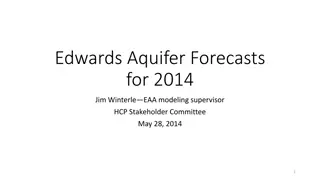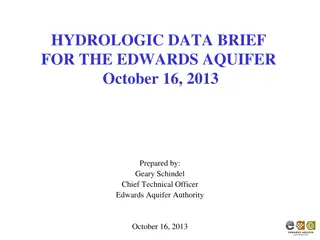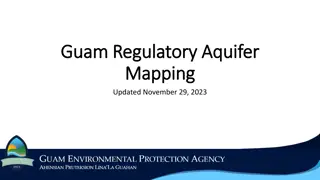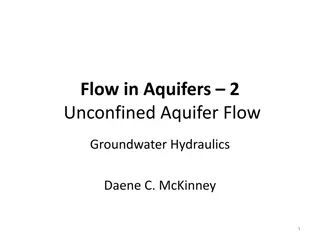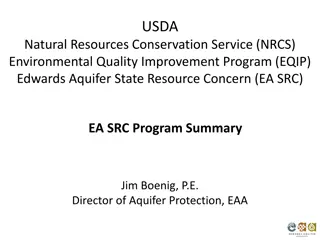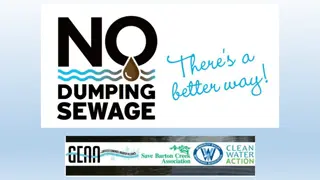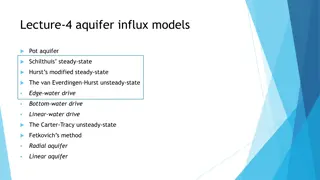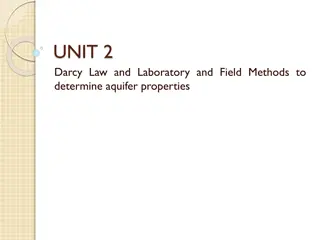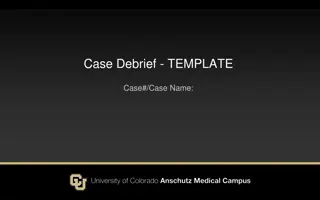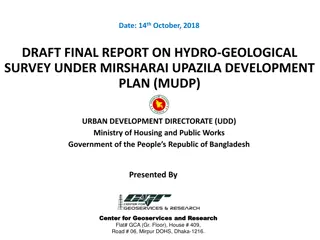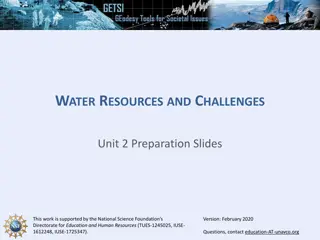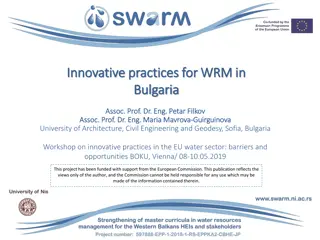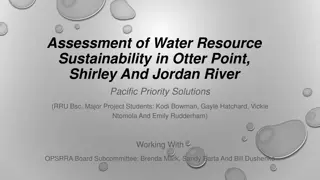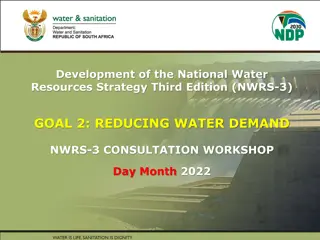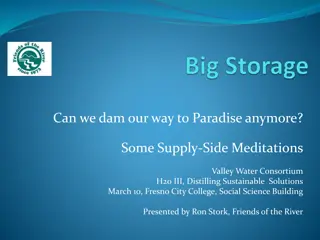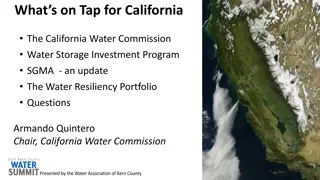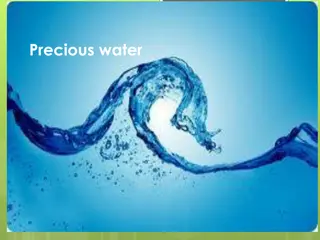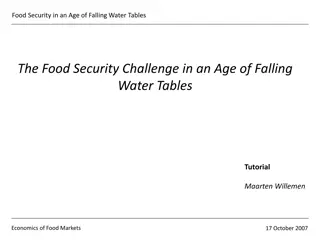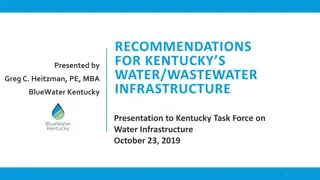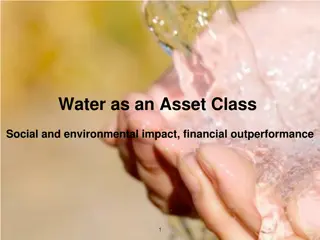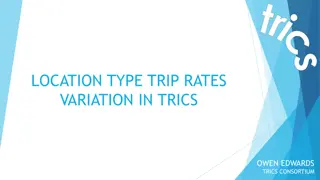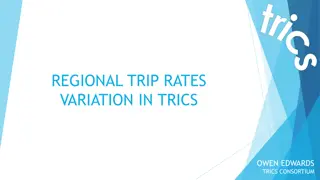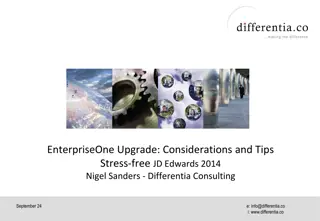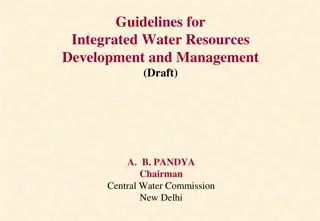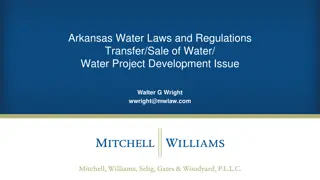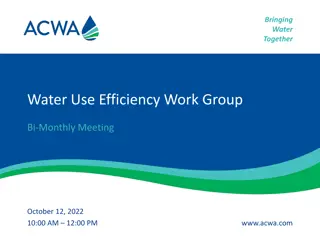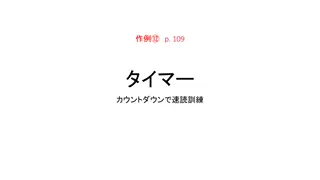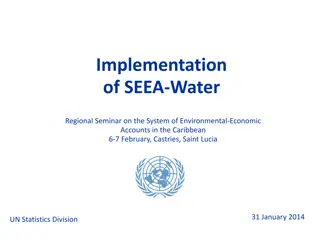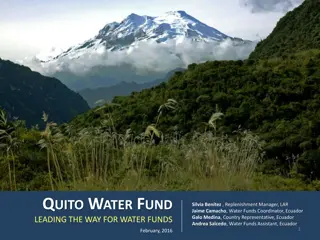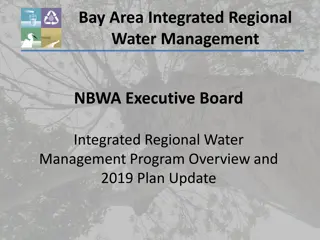The Edwards Aquifer Water Management Challenges
The Edwards Aquifer in South-Central Texas faces significant water management challenges due to reduced recharge and water levels, impacting springs and species dependent on them. Stakeholders have struggled to develop a plan, facing obstacles such as cost concerns, opposition from agricultural communities, and lack of consensus on regulatory actions. Our approach involves creating scenarios to illustrate the complexities of managing water resources, focusing on the agricultural industry as a key consumer with similar concerns.
Download Presentation

Please find below an Image/Link to download the presentation.
The content on the website is provided AS IS for your information and personal use only. It may not be sold, licensed, or shared on other websites without obtaining consent from the author. Download presentation by click this link. If you encounter any issues during the download, it is possible that the publisher has removed the file from their server.
E N D
Presentation Transcript
THE EDWARDS AQUIFER: DECISION PATHWAYS, FALL 2015 Jordan Alexander David Anderson Allison Berti Katie Cunningham SaloniTandon Damian Wahlmeier
Introduction The Edwards Aquifer is the main source of water in South-Central Texas It is used for agricultural, industrial, municipal, and recreational purposes The Drought of Record hit Texas in the 1950s, affecting the aquifer s recharge and water levels Consequently, there was reduced flow in the San Marcos and Comal springs, threatening species that rely on those springs It soon became clear that the aquifer needed to be managed to ensure that withdrawal did not exceed recharge If current withdrawal rates continue, both the Comal and San Marcos springs face a three year dry period The Edwards Aquifer region and the counties encompassing it. http://www.edwardsaquifer.net/
Edwards Aquifer Water Levels Recorded by Well J- 17 from 1999-2014 This chart shows a decrease in overall water levels after 2008. http://www.edwardsaquifer.org/dataflow/api/chart/display
The Problem Various stakeholders of the Edwards Aquifer Recovery Implementation Program (EARIP) have tried, unsuccessfully, to develop a water management plan. Some thought that San Antonio should develop an alternative water source to lessen the amount they withdraw from the aquifer. This was unsuccessful because using the aquifer was cheaper than investing in new sources. Others suggested that agricultural industries have their water use regulated. This was met with large opposition from agricultural communities who had private property rights and were pumping under the Rule of Capture. Ultimately, a plan never developed because the stakeholders could not agree on what action to take. There was an overall lack of interest in changing current practices and making the necessary investments and sacrifices in order to ensure a stable water supply in the future.
Our Approach Managing the Edwards Aquifer is a complex problem due to the amount of stakeholders and their history of distrust and disagreement. To help convey the water management problem, we created several scenarios to show the effects of variables like discharge, recharge, and precipitation. We decided to focus on the agricultural industry, the second largest consumer of water, and create a stakeholder that would have similar concerns as the other stakeholders of the Edwards Aquifer.
The Stakeholder Like other stakeholders, the farmer is concerned with ensuring he has a steady water supply now and in the future, yet needs to consider the economic benefits of pumping water from the Edwards Aquifer at current rates and using this water source over another. The farmer needs to use water from the aquifer for irrigation, and under the Rule of Capture he can pump as much groundwater (state controls surface water) as he wants as long as he can use it without waste. It is in the farmer s interest to capture the most water he can use because if he doesn t, other farmers will. The farmer wants to pump enough water now to produce an economically viable harvest but has to consider water levels for his future crops and the effects of his pumping rates, i.e. reduced spring flow and its effect on threatened and endangered species.
The Process Met in groups on Monday/Tuesday Assumed various roles o Jordan, David, Katie: modeling o Allison, Saloni, Damian: scenarios and interface Created Mental Modeler concept map to develop and organize ideas 1. Initial focus was education 2. Difficult to model education, needed to switch focus to something with more data 3. Began using Insight Maker to model variables like discharge, recharge, and precipitation 4. Began using Twinery to develop interface and storytelling aspect of project 5. Developed Scenarios using SWOT and TOWS 6. Had difficulties with Insight Maker, began to use MatLab 7.
Cross impact analysis (SWOT): Strengths Weaknesses Opportunities Threats 1. Technology 2. irrigation Systems 3. Good farmer relations 4. positive consumer image 1. Unregulated pumping 2. lack of cooperation/co mmunication 3. lack of information or awareness 1. $2 per acre feet 2. High crop demand 3. Government incentives 4. High rain fall 1. Precipitation 2. Climate 3. Endangered species 4.
Assessment of impact on stakeholders (TOWS matrix): Strengths S1. Agricultural technology/ irrigation systems S2. Efficient crop yield S3. Available land Weaknesses W1. Lack of cooperation and communication between farmers and policy makers W2. Unregulated pumping W3. Lack of awareness and information about agriculture effects Opportunities O1. Government incentives to pump less O2. High rain fall O3. Growing tomato market O1: S1, S2 O2: S1, S2 O3: S1, S2, S3 O1: W2, W3 O2: W2 O3: W1, W2 Threats T1. Population increase in municipal areas T2. Drought T3. Endangered species T1: S1, S2, S3 T2: S1 T3: S1, S2 T1: W1, W2 T2: W2 T3: W2
Insight Maker Stocks/flows used Run model a few times, what it shows Talk about experience with it, likes and dislikes
MatLab Variables used Run model a few times, what it shows Talk about experience with it, likes and dislikes, why it was preferred over Insight Maker
Twinery Originally incorporated Twinery to create interface component of project Used scenarios from SWOT/TOWS to create stories Goes through a series of events where the player has to make choices and there will be different outcomes based on the decision made *Run through once or twice*


